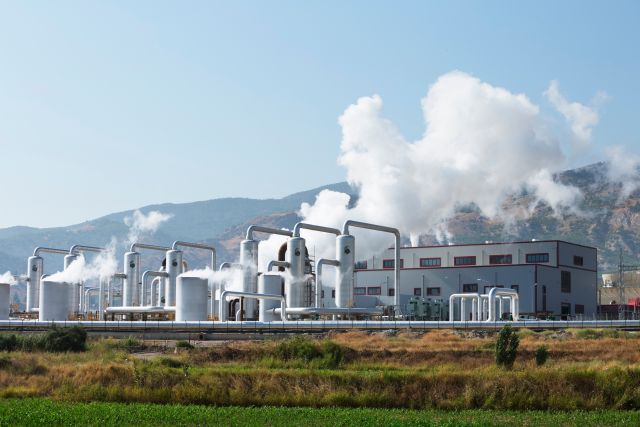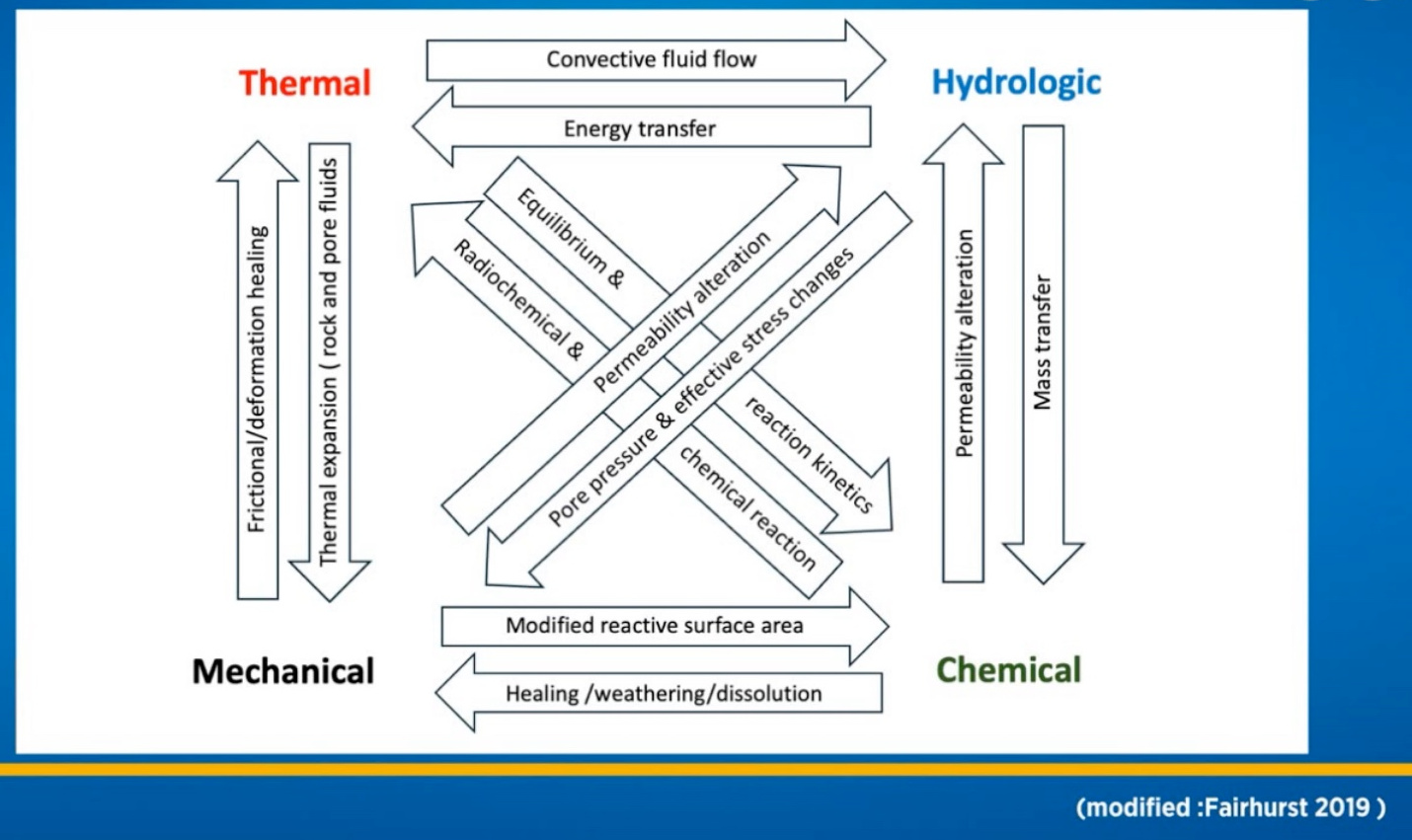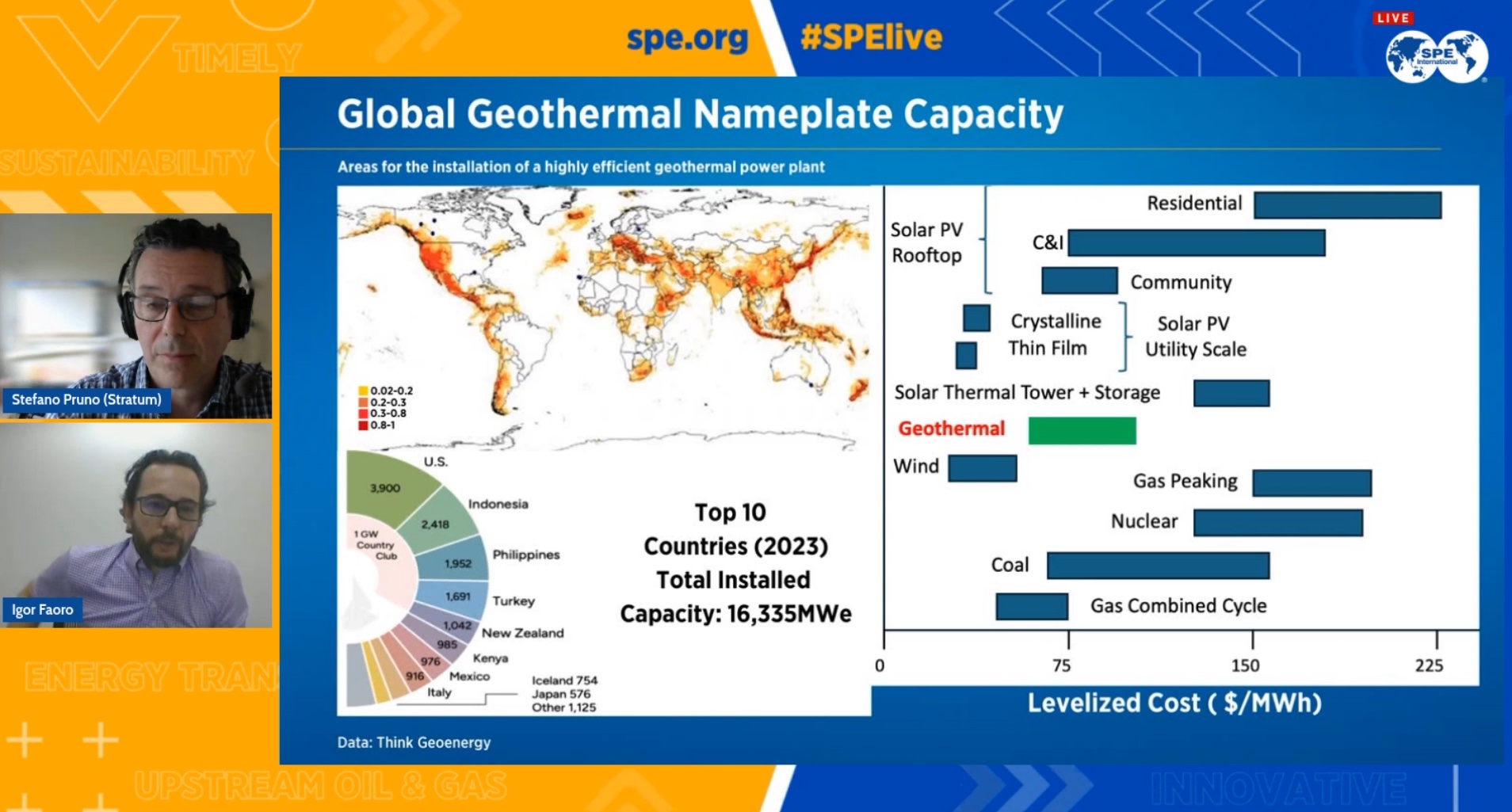
A geothermal power station. (Source: Shutterstock)
Knowledge is (geothermal) power. Geothermal systems require heat, fluid and permeability, at a minimum. But successfully harnessing heat also demands expertise on rock fractures and the reservoir’s mechanical, thermal, hydrologic and chemical characteristics.
“When we laboratory test or even when we want to understand reservoir behavior, we need to understand that these mechanisms are correlated to each other,” said Igor Faoro, technical adviser of geomechanics for Stratum Reservoir.
Speaking during an SPE webinar on Aug. 19, Faoro shared insight about how rock fractures’ transport and mechanical properties are vital when it comes to reservoir engineering for geothermal assets.
Geothermal energy captures heat from belowground using wells drilled into hot rock. While geothermal energy has been around for thousands of years, the renewable energy source is not widely used. Limitations included proximity to heat and costs.
However, efforts are underway to change that, including in the U.S. where the ambition is to deploy 60 gigawatts of enhanced geothermal systems and hydrothermal resources to help power electric grids by 2035.
But tapping heat from the Earth’s core is not as simple as picking a hot spot, drilling a pair of injection and producer wells and hoping for the best. Understanding the behavior and geomechanics of fracture-dominated reservoirs is a must before moving from the lab to the field, experts say. Research has shown that changes in chemical, hydrologic flow, mechanical deformation and temperature can impact fracture permeability—which can improve or worsen heat extraction efficiency for geothermal wells.
Interconnected parts
When it comes to modeling subsurface reservoirs such as geothermal, the mechanical, thermal, hydrological and chemical processes need to be considered, Faoro said, noting modifications to each can lead to changes in the reservoir.
“For example, if you want to study fracture conductivity behavior and long-term fracture conductivity behavior of a core … we need to consider that at the beginning. We start from the mechanical point of view,” he explained. “There are in situ stresses that need to be considered and replicated. Then, there are thermal characteristics because now we are talking about geothermal fluids. So, temperature is a key role on the mechanical behavior.”
It can change the thermal expansion of the rock, the friction property of the rock and the fracture itself, Faoro added.
Another thermal complexity occurs when trying to flow through rock. “The fluid is changing because there is an energy transfer” caused by the temperature in the reservoir itself, he said.
There will also be mechanical impacts with pore pressure and effective stress changes “because of the mechanical process and over pressurized fluid, Faoro added, “and this consequently will lead to permeability alteration.”
The chemical process is another consideration, which can impact mass transfer and permeability. “You will have a modified reactive surface area because, again, the fluid and now the surface of the fracture [are] changing.”
Plus, the chemistry process can influence the thermal process.
“So, when we move from the in situ to the laboratory, what we need to consider is having enough technology and built-in experiments that have the capability to control these four mechanisms and be ready with knowledge to understand that these factors need to be controlled during the experiment, need to be interpreted and need to be understood,” Faoro said.
The insight was shared as geothermal energy companies pursue more projects to help others reach lower greenhouse gas emissions targets by using lower carbon energy sources.
The heat extracted can be used to heat or cool homes and buildings via direct use heat, for example, or generate electricity with higher temperature geothermal resources.

Growing geothermal with outside knowledge
Geothermal companies are using various techniques to extract heat, depending on location. Conventional geothermal does not require much engineering to capture heat because it’s closer to the surface, with naturally occurring fractures, fluid and high permeability.
Next-generation geothermal energy, however, uses existing oil and gas technologies to capture heat.
With an enhanced geothermal system (EGS), fluid is circulated in a pair of wells connected by fractures created in hot reservoirs. Closed-loop geothermal systems, also referred to as advanced geothermal systems, circulate fluids through closed wellbore loops in the subsurface.
Faoro said he considers EGS the most challenging. Such systems have big potential for heat transfer and can be applicable to different kinds of reservoirs. However, permeability is low and there is not enough fluid, he said, pointing out the continuous demand for water to create fractures, keep fractures open and the potential for loss of circulation fluid.
Still, companies have been making strides with EGS. Houston-based Fervo Energy, for example, uses oil and gas technology to drill horizontally, injecting fluid underground to create fractures in hot rock for its geothermal wells. Companies are also using chemical tracers to gain subsurface data. RESMAN Energy Technology used its chemical tracers, which essentially behave like the target fluid, to gain subsurface data during Utah FORGE’s testing in April.
Geothermal companies are also turning old wells into geothermal producers with closed-loop systems in the Eagle Ford.
RELATED
Longevity in Mind, Utah FORGE and Partners De-risk Tech to Advance Geothermal
The New Wildcatters: Geothermal Developers on the Hunt for Heat
Despite the progress, costs continue to affect the pace of geothermal development.

Upfront project costs are still high relative to return profitability, Faoro said, especially with other barriers involving policy and technology, among other issues.
The levelized costs of geothermal energy compared to other forms of energy also needs improvement, Faoro said.
“Geothermal is still more expensive than the gas combined cycle …. and in terms of green energy, it’s a little bit more expensive than wind,” Faoro said. However, with more development, hopes are costs will fall and geothermal will become more competitive with other forms of energy.
Recommended Reading
BlackRock CEO: US Headed for More Inflation in Short Term
2025-03-11 - AI is likely to cause a period of deflation, Larry Fink, founder and CEO of the investment giant BlackRock, said at CERAWeek.
Stonepeak Backs Longview for Electric Transmission Projects
2025-03-24 - Newly formed Longview Infrastructure will partner with Stonepeak as electric demand increases from data centers and U.S. electrification efforts.
What's Affecting Oil Prices This Week? (Feb. 3, 2025)
2025-02-03 - The Trump administration announced a 10% tariff on Canadian crude exports, but Stratas Advisors does not think the tariffs will have any material impact on Canadian oil production or exports to the U.S.
Michael Hillebrand Appointed Chairman of IPAA
2025-01-28 - Oil and gas executive Michael Hillebrand has been appointed chairman of the Independent Petroleum Association of America’s board of directors for a two-year term.
Trump Nominates E&P Advocate Sgamma to Head Bureau of Land Management
2025-02-12 - If confirmed by the Senate, Kathleen Sgamma, president of the Western Energy Alliance, would oversee management of approximately 245 million acres of surface lands.
Comments
Add new comment
This conversation is moderated according to Hart Energy community rules. Please read the rules before joining the discussion. If you’re experiencing any technical problems, please contact our customer care team.






